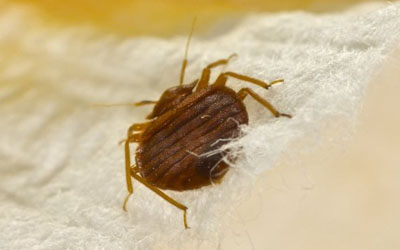Scientific / Latin name: Cimicidae
Bed bugs have had a major resurgence in the U.A.E. and every year the problem seems to be getting worse.
What are Bed Bugs and their types?
There are about 90 species of the bloodsucking insect family, Cimicidae. Of these, only three feed on humans: Cimex hemipterus, Leptocimex boueti and Cimex lectularius. The most common species of bed bug is C. lectularius. It is the cause of almost all infestations in the U.A.E.
C.lectularius and C. hemipterus feed mainly on people but will get blood meals from birds, rats, dogs and other mammals if no humans are present. Leptocimex boueti feeds mainly on bats but won’t turn down an easy human meal.
Cimex lectularius

The common Bedbug (Cimex lectularius), is found in temperate regions across the world. Usually found in human habitation, hiding in cracks and crevices, in beds and bedding in the daytime, emerging at night to feed on human blood.
Their bites don’t cause much irritation, but the bugs possess stink glands on their thorax that cause a disgusting odor when disturbed. Though they can harbor pathogens in their bodies, including plague and hepatitis B, they have not been linked to the transmission of any disease and are therefore not considered a medical threat.
However, humans can get skin infections and scars from scratching bites. For causing disgust and sheer nuisance value, Bedbugs are perhaps the No. 1 pest!
Appearance:
Adults are 4-5 mm long, wingless, rounded, flat and reddish-brown. New hatched nymphs are translucent; nymphs resemble the adults and grow through 5 moults before reaching maturity.
 Life Cycle:
Life Cycle:
Eggs (up to 350), 0.8-1.3mm long, ink-bulb-shaped, laid in cracks and crevices near host and cemented in place by glue; 5 nymphal stages lasting up to 50 days; adults can live for more than 1 year without feeding.
Where will you find Bed Bugs?

- Bed frames and headboard crevices
- Mattress seams
- Carpets and underlay
- Skirting boards
- Between timber floorboards
- In cracked or broken plaster, behind peeling wallpaper
- Inside electrical sockets and fittings
- Gaps behind wall outlets
- Areas where carpet edges meet the wall
- Drawers and cupboards
- Wardrobes
- Bedside cabinets
Common signs of Bed Bugs in the home are small red bites that often appear in a line or zigzag pattern, as well as dark spotting on carpets, mattresses, and cloth furniture from fecal droppings.
How we deal with Bed Bugs
It’s difficult to tell bed bugs apart. Common bed bugs have a wider prothorax and flatter margins than tropical bed bugs. Bat bugs have pronotum hairs that are longer than the width of their eye. Unless you’re an expert with a microscope, most bed bugs simply look the same.
To enable us to have an effective bed bugs control program, we thoroughly inspect your building concentrating on the areas you sleep. Bed bugs are nocturnal meaning they come out after dark and this is also when they feed.
Bed Bugs can be found in mattresses, bed bases, crevices and even behind pictures on the wall. Once we locate the population, we can start our integrated program and bed bugs treatment. We treat all affected areas with safe insecticides and concentrate on their harborages so most of the insecticide is out of sight.
What you can do with our help and advice
You will need to wash bedding and clothing in hot water. Thorough vacuuming of all hard floor areas, carpets, rugs and soft furniture is also required. Double bag the contents of your vacuum cleaner and dispose of them immediately.
No matter what bug is biting you, call in the pest management professionals like Desert Pest Control. All types of bed bugs that threaten your family deserve to be dealt with in the same manner: Swiftly and Severely.



